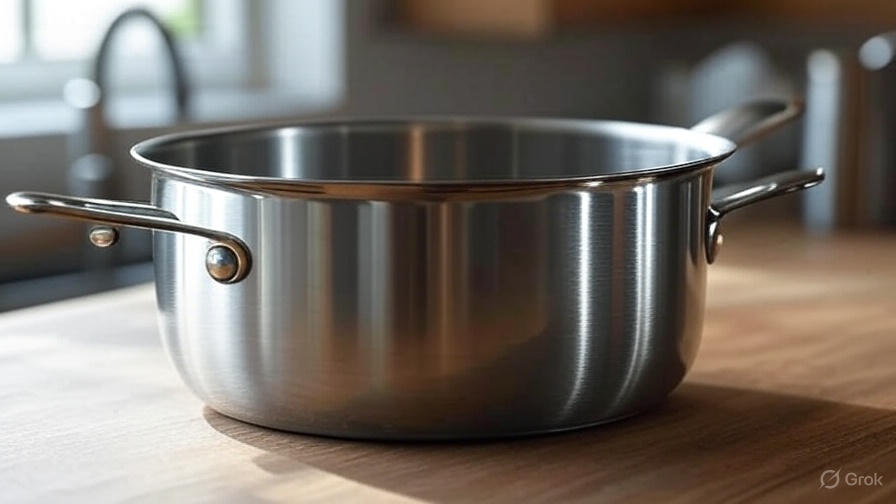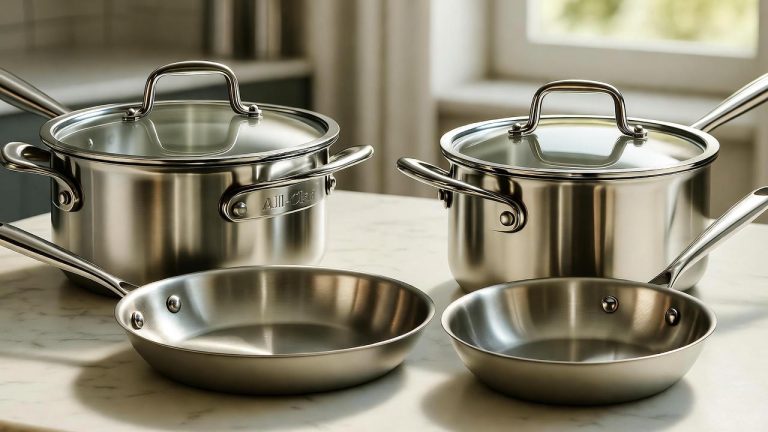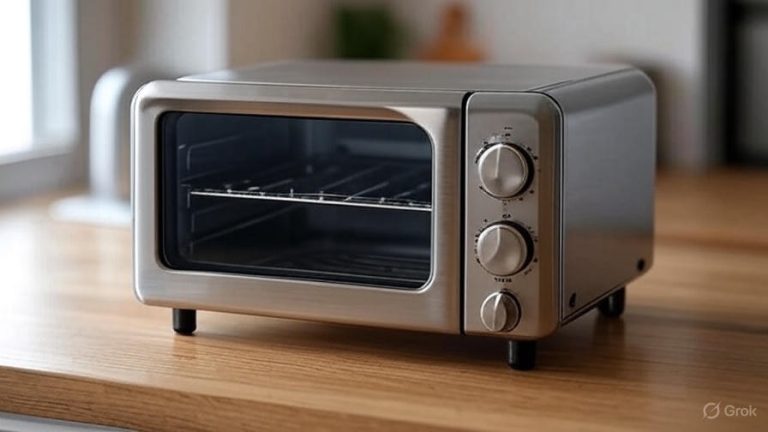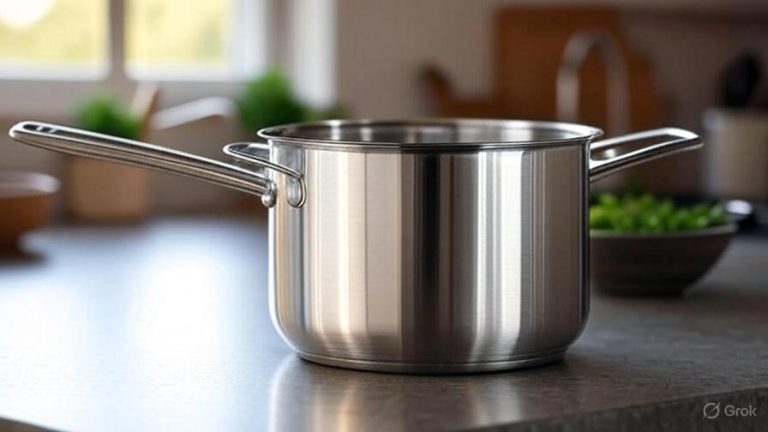5 Best 2 Qt Saucepan In 2025
Home cooking demands the right tools, and a quality 2-quart saucepan stands as one of the most versatile pieces in any kitchen arsenal. This essential cookware serves countless purposes, from melting butter and heating sauces to cooking grains and preparing small portions of vegetables. The right small saucepan can transform your culinary experience, making meal preparation more efficient and enjoyable.
Finding the ideal 2 qt saucepan requires careful consideration of materials, construction quality, heat distribution, and maintenance requirements. Today’s market offers an impressive array of options, ranging from traditional stainless steel designs to innovative ceramic-coated alternatives. Each material brings unique advantages to the table, catering to different cooking styles and preferences.
This comprehensive review examines five outstanding 2-quart saucepans, each representing different approaches to cookware design and functionality. We’ve evaluated these products based on performance, durability, ease of use, and value proposition to help you make an informed decision.
1. Blue Diamond Nonstick 2QT Saucepan: Innovative Ceramic Technology
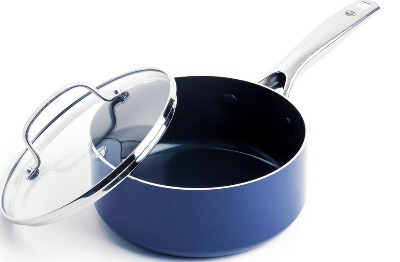
The Blue Diamond nonstick saucepan revolutionizes traditional cookware with its diamond-infused ceramic coating. This innovative approach delivers exceptional heat distribution while maintaining a completely non-toxic cooking surface. The PFAS-free diamond ceramic coating provides superior nonstick performance that outperforms conventional coatings by a significant margin.
Heat conduction proves remarkably even across the entire cooking surface, eliminating hot spots that can burn delicate sauces or scorch ingredients. The aluminum base conducts heat efficiently, while the diamond-enhanced ceramic surface ensures smooth food release without the need for excessive oils or fats. This combination makes the pan particularly well-suited for preparing cream sauces, melting chocolate, and cooking temperature-sensitive dishes.
The stay-cool handle remains comfortable to grip even during extended cooking sessions. This ergonomic design feature prevents accidental burns and allows for confident maneuvering during cooking. The handle’s construction provides excellent balance, making it easy to pour liquids or transfer contents to serving dishes.
Durability stands out as a key strength of this saucepan. The diamond ceramic coating resists scratching and chipping, even when used with metal utensils. This metal utensil compatibility sets it apart from many nonstick alternatives that require careful handling with only silicone or wooden tools. The coating maintains its performance characteristics through hundreds of cooking cycles without degradation.
Cleaning becomes effortless with this ceramic surface. Food residue slides off with minimal scrubbing, and the dishwasher-safe construction allows for convenient cleanup. The oven-safe capability up to 850°F provides versatility for techniques that require transferring from stovetop to oven, such as reducing sauces or finishing dishes under the broiler.
The glass lid fits securely and allows for easy monitoring of cooking progress without lifting and losing heat. The lid’s construction complements the pan’s overall design philosophy, combining functionality with visual appeal. The vibrant blue finish adds a pop of color to any kitchen while maintaining professional performance standards.
Price positioning reflects the advanced technology and superior materials used in construction. While the initial investment exceeds basic nonstick options, the longevity and performance justify the cost for serious home cooks who value quality and reliability.
2. Farberware Classic Stainless Steel 2-Quart Saucepan: Time-Tested Reliability
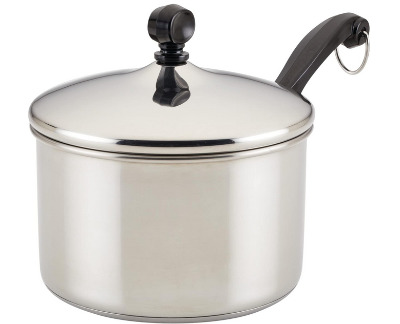
The Farberware Classic represents decades of cookware expertise condensed into a single, well-engineered saucepan. This stainless steel construction delivers the durability and performance that professional kitchens demand, making it equally suitable for home use. The mirror satin finish provides both aesthetic appeal and practical benefits, resisting fingerprints and maintaining its appearance through countless cooking sessions.
Stainless steel construction ensures compatibility with all cooktop types, including induction surfaces. The material’s non-reactive properties make it ideal for cooking acidic ingredients like tomatoes or citrus-based sauces without affecting taste or causing discoloration. This versatility allows cooks to prepare a wide range of dishes without concern for ingredient interactions.
Heat distribution occurs evenly across the cooking surface, though preheating requires slightly more time compared to aluminum-core alternatives. Once heated, the stainless steel maintains temperature consistently, providing predictable cooking results. The material’s thermal mass helps prevent sudden temperature fluctuations when ingredients are added to the pan.
The ergonomic handle design provides secure grip and stays reasonably cool during stovetop cooking. While not as thermally isolated as some competitors, the handle remains manageable with proper technique. The handle’s attachment method ensures long-term durability without loosening or wobbling over time.
Maintenance simplicity stands as a major advantage of stainless steel construction. The surface resists staining and discoloration, while scratches can often be buffed out with appropriate cleaning products. Dishwasher compatibility makes cleanup convenient, though hand washing helps maintain the mirror finish’s appearance.
The fitted lid creates an effective seal for simmering and reduces evaporation during cooking. Steam vents prevent pressure buildup while allowing moisture control for various cooking techniques. The lid’s design complements the pan’s classic aesthetic while providing functional benefits.
Longevity represents perhaps the greatest strength of this saucepan. Properly cared for stainless steel cookware can last for decades, making it an excellent long-term investment. The material won’t chip, peel, or degrade like some coating systems, ensuring consistent performance throughout its lifespan.
Value proposition proves strong for budget-conscious cooks who prioritize durability over advanced features. The reasonable price point makes quality stainless steel cookware accessible to a broad range of consumers without compromising on essential performance characteristics.
3. Cuisinart 719-18 Chef’s Classic: Professional Performance at Home
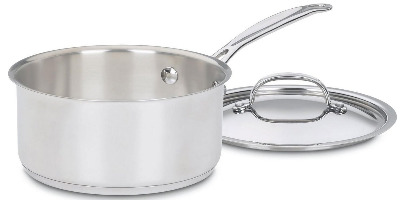
The Cuisinart Chef’s Classic brings commercial-quality construction to home kitchens through thoughtful engineering and premium materials. This stainless steel saucepan incorporates design elements that professional chefs appreciate while remaining accessible to home cooking enthusiasts. The polished exterior finish provides both durability and visual appeal that complements any kitchen decor.
Multi-layer construction enhances heat distribution beyond what single-layer stainless steel can achieve. The aluminum core sandwiched between stainless steel layers conducts heat efficiently while maintaining the non-reactive properties of stainless steel on cooking surfaces. This combination delivers faster heating times with more even temperature distribution.
The tapered rim design facilitates clean pouring without drips or spills. This attention to detail proves invaluable when transferring sauces or broths to serving vessels. The rim’s smooth finish prevents catching or snagging during cleaning while maintaining structural integrity under normal use conditions.
Handle construction emphasizes both comfort and safety through ergonomic shaping and heat-resistant materials. The riveted attachment method ensures long-term durability without loosening or separation. The handle’s length provides adequate leverage for stirring and maneuvering while keeping hands safely away from heat sources.
Temperature control becomes more precise with this pan’s responsive heating characteristics. The aluminum core reacts quickly to heat adjustments, allowing for better control over delicate cooking processes. This responsiveness proves particularly valuable when preparing temperature-sensitive sauces or reducing liquids that require careful monitoring.
Oven compatibility extends cooking possibilities beyond stovetop techniques. The pan withstands oven temperatures suitable for most home cooking applications, enabling techniques like finishing dishes under the broiler or maintaining serving temperature in warm ovens. This versatility reduces the need for transferring between cookware during complex recipes.
The tight-fitting cover traps moisture effectively while allowing steam to escape as needed. The lid’s construction matches the pan’s quality standards, providing years of reliable service. Steam circulation patterns created by the lid design promote even cooking and prevent excessive moisture loss.
Maintenance requirements remain minimal due to the high-quality stainless steel construction. The surface resists staining and maintains its appearance with basic care. Professional cleaning products can restore the original finish if deep cleaning becomes necessary over time.
Investment value reflects the pan’s commercial-grade construction and expected lifespan. While priced above basic alternatives, the quality justifies the cost for serious cooks who demand consistent performance and durability from their cookware.
4. SENSARTE Nonstick Saucepan: Swiss Granite Innovation
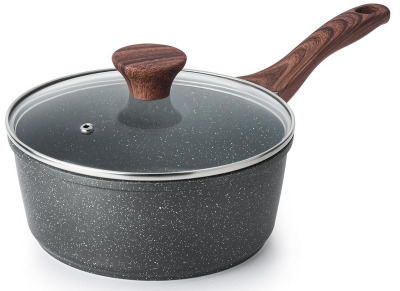
The SENSARTE saucepan introduces Swiss granite coating technology that combines nonstick convenience with exceptional durability. This innovative surface treatment provides superior food release properties while maintaining resistance to scratching and wear that exceeds traditional nonstick coatings. The granite-inspired finish adds visual interest while delivering practical cooking benefits.
Cooking performance excels across a wide range of applications, from delicate egg dishes to hearty sauces that might stick to traditional surfaces. The nonstick properties reduce the need for cooking oils and fats, supporting healthier cooking methods without sacrificing flavor or texture. Food releases cleanly even when cooking techniques involve high heat or extended cooking times.
The PFOA-free construction addresses health concerns associated with traditional nonstick coatings. This commitment to safe materials ensures that no harmful chemicals leach into food during cooking, even at higher temperatures. The coating remains stable and intact through normal cooking cycles without degradation or flaking.
Induction compatibility expands the pan’s versatility across different cooktop types. The magnetic base works efficiently with induction systems while also performing well on gas and electric surfaces. This universal compatibility makes the pan suitable for any kitchen configuration without performance compromises.
The stay-cool handle design prioritizes user safety and comfort during cooking. The handle’s construction incorporates materials that resist heat transfer, keeping the grip area comfortable even during extended cooking sessions. The ergonomic shape provides secure control while pouring or stirring contents.
Cleaning simplicity represents a major advantage of the granite coating system. Food residue wipes away easily with minimal scrubbing, and the surface resists staining from strongly colored ingredients. The dishwasher-safe construction allows for convenient cleanup, though hand washing helps preserve the coating’s longevity.
Heat distribution occurs evenly across the cooking surface, preventing hot spots that could cause sticking or burning. The aluminum base conducts heat efficiently while the coating maintains consistent nonstick properties throughout the cooking surface. This combination ensures reliable performance across various cooking techniques.
The compact 2-quart capacity proves ideal for small-batch cooking and sauce preparation. The size works well for couples or small families while also serving as a secondary pan in larger kitchens. The proportions create optimal surface area to depth ratios for effective heat transfer and cooking control.
Durability testing shows the granite coating maintains its properties through extensive use cycles. Unlike traditional nonstick surfaces that may deteriorate quickly, this coating system provides extended service life with proper care. The investment in quality materials translates to longer replacement intervals and better long-term value.
5. Tramontina Signature Tri-Ply: Brazilian Craftsmanship Excellence
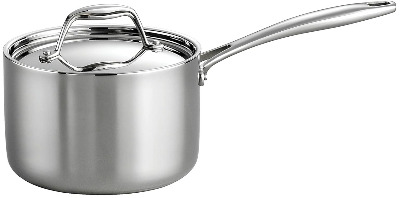
The Tramontina Signature represents the pinnacle of Brazilian cookware manufacturing, combining traditional craftsmanship with modern materials science. This tri-ply construction creates superior heat distribution through three distinct metal layers that work together to eliminate hot spots and provide consistent cooking results. The attention to detail evident in every aspect of construction reflects decades of metalworking expertise.
Tri-ply technology sandwiches an aluminum core between two layers of stainless steel, creating optimal thermal properties. The aluminum conducts heat rapidly and evenly, while the stainless steel provides durability and non-reactive cooking surfaces. This construction method delivers performance characteristics that surpass single-layer alternatives significantly.
Professional-grade construction meets NSF certification standards, indicating suitability for commercial food service applications. This certification level ensures the pan meets rigorous standards for materials safety, construction quality, and performance consistency. Home cooks benefit from the same quality standards that professional kitchens demand.
Induction readiness ensures compatibility with modern cooktop technology while maintaining excellent performance on traditional gas and electric surfaces. The magnetic base properties optimize energy transfer in induction cooking while the tri-ply construction benefits all heating methods. This versatility makes the pan suitable for any kitchen configuration.
The precision-engineered handle provides exceptional balance and control during cooking operations. The riveted attachment method ensures permanent connection without loosening over time. The handle’s design incorporates heat-resistant properties that keep the grip area comfortable even during high-temperature cooking.
Oven safety extends cooking possibilities beyond stovetop applications. The pan withstands high oven temperatures suitable for braising, roasting, and finishing techniques that require oven use. This versatility eliminates the need for transferring between cookware during complex recipes that combine stovetop and oven methods.
The fitted lid creates an effective seal for braising and simmering applications. Steam circulation patterns promote even cooking while preventing excessive moisture loss. The lid’s construction quality matches the pan’s standards, ensuring long-term reliability and consistent performance.
Brazilian manufacturing brings unique advantages through specialized expertise in metalworking and finishing techniques. The production facilities maintain quality control standards that ensure consistency across production runs. This attention to detail results in cookware that performs reliably throughout its extended lifespan.
Dishwasher safety simplifies maintenance without compromising the pan’s finish or performance characteristics. The high-quality stainless steel construction resists water spots and maintains its appearance through repeated washing cycles. Professional cleaning products can restore original luster if intensive cleaning becomes necessary.
Long-term value proposition reflects the pan’s commercial-grade construction and expected service life. While the initial investment exceeds budget alternatives, the quality construction ensures decades of reliable performance with proper care. This longevity makes the pan an excellent choice for serious cooks who view cookware as long-term kitchen investments.
Buying Guide: Essential Considerations for 2 Qt Saucepan Selection
Material composition significantly impacts cooking performance, maintenance requirements, and longevity. Stainless steel offers durability and non-reactive properties that work well with acidic ingredients. Aluminum provides excellent heat conduction but may react with certain foods. Nonstick coatings reduce oil requirements and simplify cleaning but may have limited lifespans.
Heat distribution patterns affect cooking results and prevent hot spots that can burn ingredients. Look for designs that incorporate aluminum bases or cores to improve heat conduction in stainless steel pans. Even heating prevents scorching and ensures consistent results across the cooking surface.
Handle design influences safety, comfort, and control during cooking operations. Stay-cool handles prevent burns, while ergonomic shapes reduce hand fatigue during extended use. Riveted attachments provide superior durability compared to welded or screwed connections that may loosen over time.
Compatibility with your cooktop type ensures optimal performance and energy efficiency. Induction cooktops require magnetic bases, while gas and electric surfaces work with most materials. Consider future kitchen upgrades when evaluating compatibility requirements.
Capacity and proportions should match your typical cooking needs. A 2-quart size works well for small-batch cooking, sauce preparation, and side dishes. Consider the relationship between diameter and depth for your preferred cooking techniques and ingredient volumes.
Maintenance requirements vary significantly between different materials and coatings. Nonstick surfaces may require gentle cleaning and careful handling, while stainless steel can withstand more aggressive cleaning methods. Consider your willingness to follow specific care instructions.
Lid design affects moisture retention, heat circulation, and cooking control. Well-fitted lids reduce evaporation and maintain cooking temperatures. Glass lids allow visual monitoring, while metal lids may provide better heat retention and durability.
Price versus value calculations should consider expected lifespan and performance characteristics. Higher initial costs may be justified by superior materials, construction quality, and longevity. Budget options may suffice for occasional use but might require earlier replacement.
Warranty coverage indicates manufacturer confidence in product quality and provides protection against defects. Longer warranties typically correlate with higher build quality and materials standards. Consider warranty terms when comparing similar products at different price points.
Brand reputation reflects cumulative customer experiences and quality consistency across product lines. Established manufacturers often provide better customer support and replacement part availability. Research user reviews and professional assessments to gauge real-world performance.
Performance Testing: Real-World Cooking Scenarios
Heat distribution testing reveals significant differences between saucepan designs and materials. Stainless steel pans with aluminum cores or bases heat more evenly than single-layer construction. Nonstick surfaces may mask minor hot spots but don’t eliminate underlying heat distribution issues in inferior base materials.
Sauce preparation challenges different aspects of saucepan performance. Delicate sauces require gentle, even heating to prevent separation or scorching. The Blue Diamond ceramic coating excels in this application, providing superior nonstick properties that prevent sticking without hot spots. Traditional stainless steel options like the Cuisinart require more attention but offer excellent control once proper technique is mastered.
Pasta cooking tests capacity and heat retention capabilities. The 2-quart size accommodates small portions of pasta while providing adequate water volume for proper cooking. All tested pans handle this application well, though the tri-ply Tramontina maintains water temperature most consistently when pasta is added.
Vegetable steaming evaluates lid effectiveness and moisture control. Properly fitted lids create steam environments that cook vegetables evenly while preserving nutrients. The Farberware’s traditional lid design performs reliably, while the SENSARTE’s tight seal provides excellent steam retention for efficient cooking.
Cleanup testing assesses practical maintenance requirements across different surfaces and cooking applications. Nonstick surfaces like those on the Blue Diamond and SENSARTE models require minimal effort for most cooking tasks. Stainless steel options need more scrubbing but tolerate aggressive cleaning methods when necessary.
Temperature control responsiveness varies between materials and construction methods. Aluminum-core pans like the Cuisinart respond quickly to heat adjustments, allowing precise temperature control. Single-layer stainless steel options respond more slowly but maintain temperatures consistently once established.
Durability assessments examine long-term performance under normal use conditions. Stainless steel construction generally provides the longest service life, while nonstick coatings may require eventual replacement. The Blue Diamond’s diamond ceramic coating shows superior durability compared to traditional nonstick surfaces.
Material Science: Understanding Cookware Construction
Stainless steel composition affects performance characteristics and maintenance requirements. High-grade stainless steel resists corrosion, staining, and flavor absorption while providing non-reactive cooking surfaces. The specific alloy composition determines magnetic properties needed for induction compatibility and overall durability.
Aluminum’s thermal properties make it ideal for heat conduction applications. Pure aluminum conducts heat approximately four times faster than stainless steel, explaining its use in base layers and cores. However, aluminum’s reactive nature with acidic foods necessitates protective stainless steel layers in quality cookware.
Ceramic coatings provide nonstick properties without the chemical concerns associated with traditional PTFE-based surfaces. Modern ceramic systems like the Blue Diamond’s diamond-enhanced coating offer improved durability and heat resistance compared to early ceramic nonstick technologies.
Tri-ply construction optimizes thermal performance by combining materials with complementary properties. The aluminum core provides rapid heat conduction, while stainless steel layers offer durability and non-reactive surfaces. This combination delivers superior performance compared to single-layer alternatives.
Manufacturing processes affect final product quality and performance characteristics. Drawing, stamping, and forming operations influence metal grain structure and stress patterns. Quality manufacturers use controlled processes that optimize material properties while maintaining dimensional accuracy.
Surface treatments enhance functionality and appearance while affecting maintenance requirements. Polished finishes resist staining and simplify cleaning, while textured surfaces may provide improved heat distribution or nonstick properties. Consider how surface treatments align with your cooking style and maintenance preferences.
Quality control standards ensure consistency across production runs and compliance with safety regulations. NSF certification indicates commercial-grade quality standards, while other certifications address specific performance or safety criteria. These standards provide confidence in product reliability and safety.
Cooking Techniques: Maximizing Saucepan Performance
Preheating techniques vary between materials and significantly impact cooking results. Stainless steel pans benefit from gradual preheating to ensure even temperature distribution. Nonstick surfaces require minimal preheating to prevent coating damage from excessive heat exposure.
Temperature control mastery enables better cooking results across various techniques. Medium heat settings work well for most saucepan applications, while high heat may be necessary for rapid boiling or searing. Learn to recognize visual and auditory cues that indicate proper temperature levels.
Stirring methods prevent sticking and ensure even cooking without damaging cookware surfaces. Wooden and silicone utensils work well with nonstick coatings, while metal utensils are acceptable for stainless steel and some ceramic surfaces. Proper stirring technique distributes heat and prevents hot spots.
Sauce reduction requires careful heat management and patience for optimal results. Lower temperatures and longer cooking times produce better flavor concentration without scorching. The wide surface area of a quality saucepan promotes efficient evaporation during reduction processes.
Deglazing techniques recover flavorful fond from pan bottoms while creating bases for sauces and gravies. This process works best with stainless steel surfaces that develop fond naturally. Nonstick surfaces may not develop significant fond, limiting deglazing opportunities.
Simmering control prevents boiling over while maintaining gentle cooking action. Proper lid positioning allows steam escape while retaining moisture and heat. Different recipes require varying degrees of coverage for optimal results.
Heat transfer optimization involves understanding how different materials conduct and retain heat. Preheating aluminum-core pans requires less time but offers more responsive temperature control. Solid stainless steel takes longer to heat but maintains temperature more consistently.
Maintenance and Care: Extending Cookware Lifespan
Cleaning protocols vary significantly between different cookware materials and coatings. Nonstick surfaces require gentle cleaning with soft sponges and mild detergents to preserve coating integrity. Stainless steel can withstand more aggressive cleaning methods including abrasive cleaners when necessary.
Storage considerations prevent damage and extend cookware lifespan. Nonstick surfaces benefit from protective padding or hanging storage to prevent scratching. Stainless steel is more resilient but still benefits from proper storage that prevents dents and scratches.
Seasoning requirements apply primarily to certain materials and cooking applications. While most modern cookware doesn’t require traditional seasoning, some benefit from occasional oil treatments that enhance nonstick properties and prevent corrosion.
Temperature limitations protect cookware from damage and maintain performance characteristics. Nonstick coatings may degrade at high temperatures, while stainless steel typically handles high heat applications safely. Understanding limits prevents premature failure and safety hazards.
Dishwasher compatibility varies between products and may affect appearance over time. While many modern pans are dishwasher-safe, hand washing often provides better care and preserves finishes longer. Consider your preference for convenience versus optimal care.
Replacement indicators help determine when cookware has reached the end of its useful life. Nonstick coatings that chip, peel, or lose effectiveness require replacement for safety and performance reasons. Stainless steel may last decades with proper care but may need replacement if damaged or warped.
Professional restoration services can sometimes extend the life of quality cookware through refinishing or reconditioning. This option may be cost-effective for premium pieces that develop minor damage or lose their original appearance over time.
Value Analysis: Cost Versus Performance Considerations
Initial investment costs vary widely across different materials, construction methods, and brand positioning. Budget options may provide adequate performance for occasional use, while premium alternatives offer superior durability and performance characteristics that justify higher costs for serious cooks.
Long-term ownership costs include replacement intervals, maintenance requirements, and energy efficiency considerations. Durable cookware may cost more initially but provide better value through extended service life and consistent performance. Consider total ownership costs rather than just purchase price.
Performance per dollar calculations help compare options across different price ranges. Some mid-range products offer excellent performance that rivals premium alternatives at significant cost savings. Identify features that matter most for your cooking style and budget accordingly.
Brand premium assessments determine whether reputation translates to proportional value. Established brands often provide better customer support and quality consistency, but may charge premium prices for their reputation. Compare actual performance and features rather than relying solely on brand recognition.
Warranty value considers coverage duration and terms relative to purchase price and expected lifespan. Comprehensive warranties provide protection against defects and may indicate manufacturer confidence in product quality. Factor warranty terms into value calculations when comparing similar products.
Resale value considerations apply mainly to premium cookware that retains value over time. High-quality stainless steel cookware may retain significant resale value, while nonstick products typically have minimal resale potential due to coating degradation over time.
Conclusion: Making Your Perfect Choice
The ideal 2-quart saucepan depends on your specific cooking needs, maintenance preferences, and budget considerations. Each reviewed product offers distinct advantages that appeal to different cooking styles and priorities.
The Blue Diamond represents the pinnacle of nonstick technology, combining innovative ceramic coating with excellent durability and performance. This option works best for cooks who prioritize easy cleanup and healthy cooking methods while appreciating advanced materials technology.
The Farberware Classic delivers time-tested stainless steel reliability at an accessible price point. This traditional approach appeals to budget-conscious cooks who value durability and don’t mind slightly more involved maintenance routines.
The Cuisinart Chef’s Classic elevates stainless steel construction with professional-grade features and superior heat distribution. This option suits serious home cooks who demand consistent performance and appreciate thoughtful design details.
The SENSARTE offers innovative granite coating technology that balances nonstick convenience with enhanced durability. This modern approach works well for health-conscious cooks who want nonstick performance without traditional coating concerns.
The Tramontina Signature showcases tri-ply construction excellence with commercial-grade quality and NSF certification. This premium option appeals to cooking enthusiasts who view cookware as long-term investments in their culinary capabilities.
Consider your cooking frequency, preferred maintenance level, and budget constraints when making your final decision. Each of these exceptional saucepans can serve as the foundation for countless delicious meals and cooking adventures in your kitchen.

